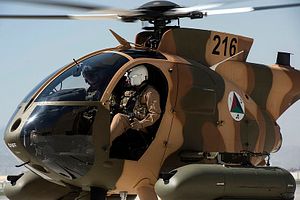Just this past August, Afghanistan received delivery of the final four out of 27 MD-530 Cayuse Warrior helicopters from the U.S. Air Force. On Thursday morning, four of those aircraft were delivered to the Shaheen Military Corps in northern Balk province. Presiding over the ceremony in Mazar-i-Sharif was Afghan Air Force Chief General Abdul Wahab Wardak, who lauded the delivery as strengthening the Afghan Air force.
Afghanistan has struggled to field a competent air force over the years, somewhat in part due to U.S. delays in building and training the new unit. An air force for any country is expensive, and for a country like Afghanistan that translates into fielding aircraft that the war torn region can afford to maintain and equip.
Afghanistan’s fleet of aircraft largely consists of Russian made Mi-25 helicopter gunships and Mi-17 transport helicopters. The United States has provided Afghanistan with MD-530 Cayuse Warriors that come equipped with light rockets and .50 caliber machine guns.
New to the battlefield this year is the A-29 Super Tucano, a fixed wing light attack propeller based aircraft. Afghanistan is contracted to receive 20 and so far has received eight of these air frames. The A-29 provides new capabilities to include longer flight durations, heavier munitions capabilities, and longer loiter periods over targets. The airplane has already been put to considerable use, with 260 sorties flown reported in May alone.
Air support is a necessary component in any counterinsurgency; considering Afghanistan’s mountainous and formidable terrain, it is vital.
Mi-17 helicopters provide transport for Afghan forces conducting night time raids on suspected Taliban insurgent leaders, providing speed, swiftness, and an element of surprise. Even more important, however, is the ability to provide medical casualty evacuation (medivac).
Success in war is as much about tactics and strategy as it is about psychology and morale. Troops leaving their military bases on combat operations in hostile territory want to know that should they become injured, they have transport waiting to take them to safety and care. In a 2013 interview with Stars and Stripes, Col. Matthew Lewis, commander of the 1st Combat Aviation Brigade said, “It’s a tough mission to convince a young man to go out there, but if you know you’re going to be evacuated, if you know that someone’s got your back, you’re more likely to go out and do your mission.”
Poor medivac capabilities drain force morale, but also increase casualty rates and deaths from non-fatal injuries and bleed outs.
Afghanistan has struggled since the drawdown of NATO forces began to maintain proper medivac standards. It is currently unknown what the current capabilities with regards to this capacity are, as the latest SIGAR report (from 2015) to mention Afghan medivac capabilities remains classified.
However, the drawdown of Coalition forces has had an impact on Afghanistan’s ability to conduct counternarcotic (CN) interdiction operations as critical enablers such as quick reaction forces, close air support, and dedicated medical evacuation support are no longer available.
The ability to drop heavy munitions from the air or to conduct rapid fly overs and show of force operations impact both friendly and hostile units. As stated earlier, morale and psychology are key elements of success on the battlefield.
The collapse of Mosul in Iraq to a far smaller attacking force highlights this point; exposure to social media that indicated a mythical and unbeatable ISIS force caused Iraqi units to abandon their posts.
Afghanistan’s A-29 Super Tucanos provide a new capability to Afghan forces that is pivotal to forces conducting counterinsurgency operations, which is the ability to target insurgent leaders with precision strikes. The A-29 is capable of fielding GPS guided munitions kits similar to what the United States fielded in Colombia, as it assisted the central government in eliminating FARC leadership. Fast forward to the present day, and through a campaign of targeted strikes and the decimation of FARC’s leadership, the leftist guerrilla outfit recently signed a peace accord, ending the 50 year long conflict.
Afghanistan’s Air Force is still in its infancy; however, it is slowly building the capabilities and receiving the necessary air platforms to maintain sustained operations that will assist struggling Afghan forces facing a resurgent threat.































